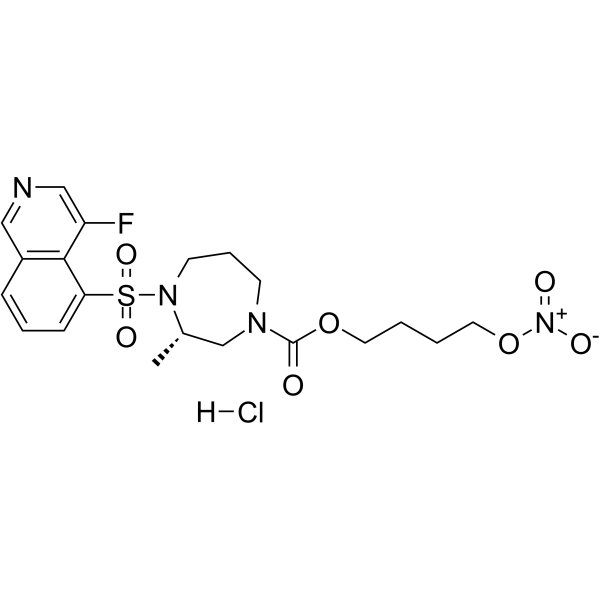| Description |
ROCK-IN-4 is a potent ROCK inhibitor maintaining NO releasing ability. ROCK-IN-4 reversibly depolymerizes F-actin, and suppresses mitochondrial respiration in human trabecular meshwork (HTM) cells. ROCK-IN-4 can be used for glaucoma or ocular hypertension research[1].
|
| Related Catalog |
|
| In Vitro |
ROCK-IN-4 (RNO-6) (10 μM; 1 h) decreases p-MLC level and induces reversible F-actin depolymerization[1]. ROCK-IN-4 (10 μM; 24 h) involves in cGMP activation, increases cGMP concentration in human trabecular meshwork (HTM) cells[1]. ROCK-IN-4 (10 μM; 1 h) suppresses mitochondrial respiration by releasing NO and remarkably decreases the basal respiration, maximal respiration, and ATP production[1]. Western Blot Analysis[1] Cell Line: Human trabecular meshwork (HTM) cells Concentration: 10 μM Incubation Time: 1 hour Result: Inhibited the phosphorylation of MLC, reduced the level of p-MLC. Immunofluorescence[1] Cell Line: Human trabecular meshwork (HTM) cells Concentration: 10 μM Incubation Time: 1 hour Result: Exhibited conspicuous F-actin depolymerization, and after recovery for 4 h, recovered F-actin to the polymerization morphology, indicating a reversible depolymerization effect without permanent damage to cells.
|
| In Vivo |
ROCK-IN-4 (0.26% w/v for 10 μL; o.p. in right eye; single dose) exhibits significant IOP lowering and (0.26% w/v for 10 μL; o.p.; 10 d) exerts visual function and retinal ganglion cell (RGC) protection activities in glaucoma mouse model[1]. ROCK-IN-4 (0.579% w/v for 25 μL; o.p. in left eye; single dose) shows low hyperemic effect and eye irritation in New Zealand White rabbits[1]. Animal Model: Chronic Ocular Hypertension Mouse Model induced by Microbead[1] Dosage: 0.26% (w/v), 10 μL Administration: Ophthalmic drop; singel dose; administration in right eye 7 days after modeling, and measured IOP prior to and at 1, 2, 3, 4, and 6 h after instillation Result: Reduced IOP (mmHg) to 3.68 ± 0.5 mmHg (19.9%) and 1.36 ± 0.6 mmHg (7.4%) at 1 and 4 h after instillation, respectively. Animal Model: New Zealand White rabbits[1] Dosage: 0.579% (w/v); 25 μL Administration: Ophthalmic drop; singel dose; administration in left eye before and at 1, 2, and 4 h after the first instillation Result: Showed low side effects in conjunctival hyperemia.
|
| References |
[1]. Yang Z, et al. Identification of Nitric Oxide-Donating Ripasudil Derivatives with Intraocular Pressure Lowering and Retinal Ganglion Cell Protection Activities. J Med Chem. 2022 Aug 25.
|
